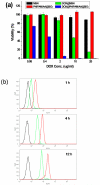Multifunctional hybrid silica nanoparticles for controlled doxorubicin loading and release with thermal and pH dually response
- PMID: 23543911
- PMCID: PMC3609667
- DOI: 10.1039/C2TB00223J
Multifunctional hybrid silica nanoparticles for controlled doxorubicin loading and release with thermal and pH dually response
Abstract
Controlled drug loading and release into tumor cells to increase the intracellular drug concentration is a major challenge for cancer therapy due to resistance and inefficient cellular uptake. Here a temperature and pH dually responsive PNiPAM/AA@SiO2 core-shell particles with internal controlled release were designed and fabricated for efficient cancer treatment, which could recognize the intrinsic pH differences between cancers and normal tissues. Upon lowering the temperature, doxorubicin was loaded into the PNiPAM/AA@SiO2 nanoparticles, whereas by increasing the acidity, previously loaded doxorubicin was quickly released. Comparing with common mesoporous silica particles (MSNs), this core-shell particle has more uniform size and better dispersity. In addition, dried PNiPAM/AA@SiO2 nanoparticles could be easily redispersed in distilled water. The in vitro cell culture experiments showed that not only PNiPAM/AA@SiO2 particles were more biocompatible and lower cytotoxic than MSN, but also DOX@PNiPAM/AA@SiO2 had higher drug releasing efficiency in the lysosomes and stronger inhibitory effect on tumor cell growth than DOX@MSN. All these features indicated that PNiPAM/AA@SiO2 particles have great potential in therapy applications.
Figures









Similar articles
-
pH and Thermal Dual-Responsive Nanoparticles for Controlled Drug Delivery with High Loading Content.ACS Omega. 2017 Jul 31;2(7):3399-3405. doi: 10.1021/acsomega.7b00367. Epub 2017 Jul 11. ACS Omega. 2017. PMID: 30023694 Free PMC article.
-
Natural gelatin capped mesoporous silica nanoparticles for intracellular acid-triggered drug delivery.Langmuir. 2013 Oct 15;29(41):12804-10. doi: 10.1021/la4022646. Epub 2013 Oct 3. Langmuir. 2013. PMID: 24073830
-
Enzyme-induced and tumor-targeted drug delivery system based on multifunctional mesoporous silica nanoparticles.ACS Appl Mater Interfaces. 2015 May 6;7(17):9078-87. doi: 10.1021/acsami.5b00752. Epub 2015 Apr 24. ACS Appl Mater Interfaces. 2015. PMID: 25893819
-
Core-Shell Structure Design of Hollow Mesoporous Silica Nanospheres Based on Thermo-Sensitive PNIPAM and pH-Responsive Catechol-Fe3+ Complex.Polymers (Basel). 2019 Nov 7;11(11):1832. doi: 10.3390/polym11111832. Polymers (Basel). 2019. PMID: 31703389 Free PMC article.
-
Encapsulating magnetic and fluorescent mesoporous silica into thermosensitive chitosan microspheres for cell imaging and controlled drug release in vitro.Colloids Surf B Biointerfaces. 2014 Jan 1;113:1-9. doi: 10.1016/j.colsurfb.2013.08.015. Epub 2013 Sep 1. Colloids Surf B Biointerfaces. 2014. PMID: 24060924
Cited by
-
Visible-light harvesting innovative W6+/Yb3+/TiO2 materials as a green methodology photocatalyst for the photodegradation of pharmaceutical pollutants.Photochem Photobiol Sci. 2021 Mar;20(3):401-420. doi: 10.1007/s43630-021-00028-8. Epub 2021 Feb 26. Photochem Photobiol Sci. 2021. PMID: 33721273
-
iRGD-Guided Silica/Gold Nanoparticles for Efficient Tumor-Targeting and Enhancing Antitumor Efficacy Against Breast Cancer.Int J Nanomedicine. 2024 Aug 12;19:8237-8251. doi: 10.2147/IJN.S474135. eCollection 2024. Int J Nanomedicine. 2024. PMID: 39157735 Free PMC article.
-
Preparation and Characterization of Thermoresponsive Poly(N-isopropylacrylamide-co-acrylic acid)-Grafted Hollow Fe₃O₄/SiO₂ Microspheres with Surface Holes for BSA Release.Materials (Basel). 2017 Apr 14;10(4):411. doi: 10.3390/ma10040411. Materials (Basel). 2017. PMID: 28772770 Free PMC article.
-
pH and Thermal Dual-Responsive Nanoparticles for Controlled Drug Delivery with High Loading Content.ACS Omega. 2017 Jul 31;2(7):3399-3405. doi: 10.1021/acsomega.7b00367. Epub 2017 Jul 11. ACS Omega. 2017. PMID: 30023694 Free PMC article.
-
Exploring the potential of lanthanide-doped oxyfluoride materials for bright green upconversion and their promising applications towards temperature sensing and drug delivery.J Mater Chem C Mater. 2024 Jun 29;12(31):11785-11802. doi: 10.1039/d4tc01740d. eCollection 2024 Aug 8. J Mater Chem C Mater. 2024. PMID: 39132257 Free PMC article.
References
-
- Choi C, Chae SY, Nah JW. Polymer. 2006;47:4571–4580.
-
- Kohori F, Sakai K, Aoyagi T, Yokoyama M, Sakurai Y, Okano T. J Control Release. 1998;55:87–98. - PubMed
-
- Chung JE, Yokoyama M, Yamato M, Aoyagi T, Sakurai Y, Okano T. Journal of Controlled Release. 1999;62:115–127. - PubMed
-
- Schmaljohann D. Advanced Drug Delivery Reviews. 2006;58:1655–1670. - PubMed
-
- Lefaux CJ, Zimberlin JA, Dobrynin AV, Mather PT. Journal of Polymer Science Part B-Polymer Physics. 2004;42:3654–3666.
Grants and funding
LinkOut - more resources
Full Text Sources
Other Literature Sources
Research Materials
Miscellaneous

